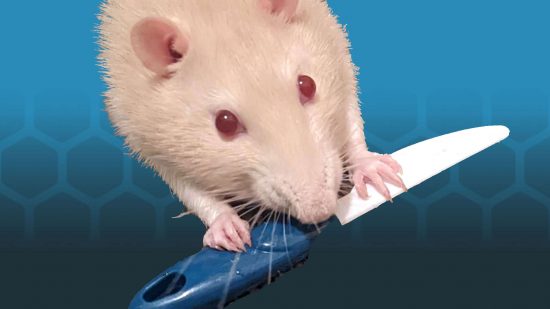The Warhammer Skaven might be Games Workshop’s greatest addition to the fantasy canon, a race of egotistical, paranoid, evil ratmen who lurk in the skirting boards of the multiverse. But how much do Skaven have in common with the terrestrial rats they’re based on?
Like the Warhammer Chaos gods, the Skaven are one of those ideas that make sense in every setting. In the Old World, Skaven are a species of chaotic rat people who wield dangerous magic and insane inventions in pursuit of their dreams of empire. Age of Sigmar Skaven are pretty much the same species, having gnawed their way out of the Old World before it was blown up during the End Times.

The Skaven are so popular that there’s big fan demand for a race of Warhammer 40k Skaven, and there are hints that the ratmen will be the title villain for Age of Sigmar 4th edition. This was all the excuse that I, and Wargamer’s resident rat-keeper Mollie Russell, needed to totally derail a work meeting by comparing the Skaven against their real-world rat counterparts.
Skaven are ingenious, using mad science to create nightmare warmachines, mutant abominations, and reality-shattering spells. Rats are also tremendously intelligent despite their tiny size. Pet rats are curious, capable of solving problems to get at food treats or simply because they want to find out how something acts – some keepers call them “pocket puppies” because they’re so playful. They even become bored of toys, so you’ll have to swap in new things for them to play with.
The flip side to Skaven ingenuity is that their inventions often go horribly wrong, blowing up in in their inventor’s face and showering everyone nearby in radioactive warpstone. Rat keepers may similarly learn that their pets are a charming blend of clever and stupid – smart enough to climb to the top of a bookshelf, but not smart enough to work out how to get down. They’re all also individuals: one rat in your care might be able to solve a puzzle to get a treat, but their dimmer companion might struggle.
In the Age of Sigmar universe, Skaven can drill tunnels called Gnaw Holes that connect their infinite city Skavenblight with any point of reality. While real rats have no such magical powers, they are quite capable of gnawing holes through wooden floorboards and panels. Like all rodents their front teeth grow continually throughout their life, counteracting the wear and tear of a coarse natural diet. Pet rats need to have things to gnaw on or their teeth will overgrow, causing health problems.
The Skaven of Clan Pestilens are all fanatical Plague Monks, devoted to their deity the Horned Rat in its aspect as the bringer of disease. While the days of the Black Death are long past, wild rats still pose a health risk to humans, for example by spreading Weil’s disease in their urine.

Pet rats will be free of these infections, though we’d always recommend washing your hands after handling them – like all rodents, rats leave a constant trickle of pee behind them wherever they go. But rats are fastidious about their hygiene, frequently grooming themselves to stay clean and healthy.
The most massive difference between Skaven and real rats is in how sociable they are, and how much they like humans. Skaven live in teeming warrens but they loathe one another, viewing all other Skaven as enemies to be removed or pawns to be exploited. Other races are even lower in their estimation.

Rats are a communal species that become depressed if they don’t have company. If they’re appropriately socialised and handled they enjoy human company and snuggles. If you want an anti-social rodent, look no further than the hamster, a solitary species that sleeps during the day, hates other hamsters, and hates to be disturbed by humans.
If you’re considering getting rats as pets, we recommend you do more research from reputable sources of pet care information. If you’re considering collecting Skaven as your next Age of Sigmar army, we recommend you brush up on how to paint miniatures quickly, because you’re going to be painting a lot of them – our guide to speed painting with Contrast paints may prove invaluable.


